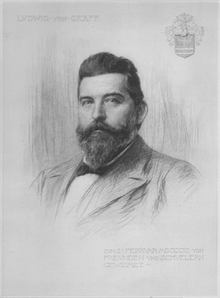Ludwig von Graff
Ludwig Graff de Pancsova (2 January 1851 – 6 February 1924), more known as Ludwig von Graff, was an Austrian zoologist born in Pancsova.
Ludwig von Graff | |
|---|---|
 Ludwig von Graff | |
| Born | Ludwig Bartholomäus Graff January 2, 1851 |
| Died | February 6, 1924 (aged 73) |
| Scientific career | |
| Fields | Zoology, Helminthology |
| Institutions | University of Graz |
| Author abbrev. (zoology) | Graff; von Graff |
In 1871 he received his medical degree in Vienna, afterwards studying zoology at the University of Graz. In 1872 he was an assistant at the zoological institute in Strasbourg, where he worked closely with Eduard Oscar Schmidt (1823–1886). In 1873 he relocated to Munich as an assistant to Karl Theodor Ernst von Siebold (1804–1885), gaining his habilitation during the following year. In 1876 he became a professor at the Academy of Forestry in Aschaffenburg, and from 1884 was a professor of zoology at the University of Graz. Here he expanded the institute of zoology and its library. In 1896-97 he was rector of the university.
Graff was a leading expert on Turbellaria (flatworms), especially remembered for research of its morphology and biological systematics. He gathered material for his studies on numerous expeditions, which included journeys to Ceylon and Java (1893–94), the Arctic Ocean (1902) and North America (1907).
With Victor von Ebner (1842–1925) and others, he founded the Gesellschaft für Morphologie und Physiologie (1907). He was also a co-founder of the Deutschen Zoologischen Gesellschaft. The 1910 International Congress of Zoologists at Graz elected him an honorary president
Selected writings
- Monographie der Turbellarien (Wien 1882, 1889); (Monograph of Turbellaria)
- Die Turbellarien als Parasiten und Wirte (Graz 1903); (Turbellaria as parasites and hosts)
- Das Schmarotzertum im Tierreich und seine Bedeutung für die Artbildung (Graz 1907); (Parasitism in animals and its importance for speciation).
References
- Deutsche Biographie (translated biography)